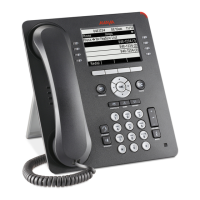About this Guide
12 Deskphone SIP 9608, 9611G, 9621G, 9641G Administrator Guide Release 6.0.1, SP1
Major differences between 9600 Series H.323 and SIP IP
Deskphones
Review this section if your administrative environment includes both SIP and H.323 signaling
protocols for 9600 Series IP Deskphones.
General IP Telephony - Two major protocols handle Voice over IP (VoIP) signaling, Session
Initiation Protocol (SIP) and H.323. The two protocols provide connection control and call
progress signaling, but in very different ways. These protocols can be used simultaneously over
the same network, but in general, no endpoint supports both protocols at the same time. Neither
protocol is necessarily superior, but each offers some unique advantages. SIP deskphones, for
example, do not require centralized call servers, and can route calls when the destination is
identified. H.323 deskphones leverage the call server’s presence into the potential availability of
hundreds of telephone-related features that a standalone SIP deskphone cannot provide.
Signaling - 96xx Series IP Deskphones ship from the factory with H.323 signaling. To use the
SIP protocol, applicable H.323 96xx Series IP Deskphones must be appropriately converted
and configured. See the Avaya one-X™ Deskphone SIP Installation and Maintenance Guide for
9608, 9611G, 9621G, and 9641G IP Deskphones (Document Number 16-603604) for detailed
conversion/configuration information.
Avaya Aura Communication Manager (CM) Release - 9600 Series SIP Deskphones are
supported only by Communication Manager Release 4.0 and greater. SIP Release 6.0 and later
has been tested with and is supported by CM Release 6.0 and Session Manager Release 6.0;
additionally, SIP software Release 6.0 works with CM 4.x or 5.x with a compatible version of
SES 4.x or 5.x, where "x" represents an additional release of that software. SIP deskphones
use Avaya OPS (Outbound SIP Proxy) features on the “trunk” side of Avaya Communication
Manager whereas the H.323 (IP) deskphones are supported on the “line” side of the
Communication Manager. When a SIP deskphone is running under Communication Manager
Release 5.0 and up, an additional feature, Extend Call, is available. The Intercom feature is
available only on CM Release 5.1 and later. When using Avaya Aura Session Manager,
Communication Manager Release 5.2.1 or later is required.
Required Servers - SIP deskphones use additional servers that H.323 deskphones do not:
- SIP Proxy server (controller) - provided by SIP Enablement Services (SES) software or
Avaya Aura
®
Session Manager (SM),
- Network Time server - which controls time-related parameters,
- Presence server - in an SES or SM environment, allows tracking of contacts designated
with a presence handle and sharing presence information with compatible software.
These servers are not necessarily separate hardware units. Additional, optional servers may be
used to handle survivability but this is dependent upon your specific configuration. Depending
on your system configuration, the servers listed above may require specific software versions,
as described in Avaya Aura
®
Communication Manager Administration.
Backup/Restore - 9600 Series (H.323) IP Deskphones use HTTP to store backup files. 9600
Series IP Deskphones with the SIP protocol use the Personal Profile Manager (PPM)

